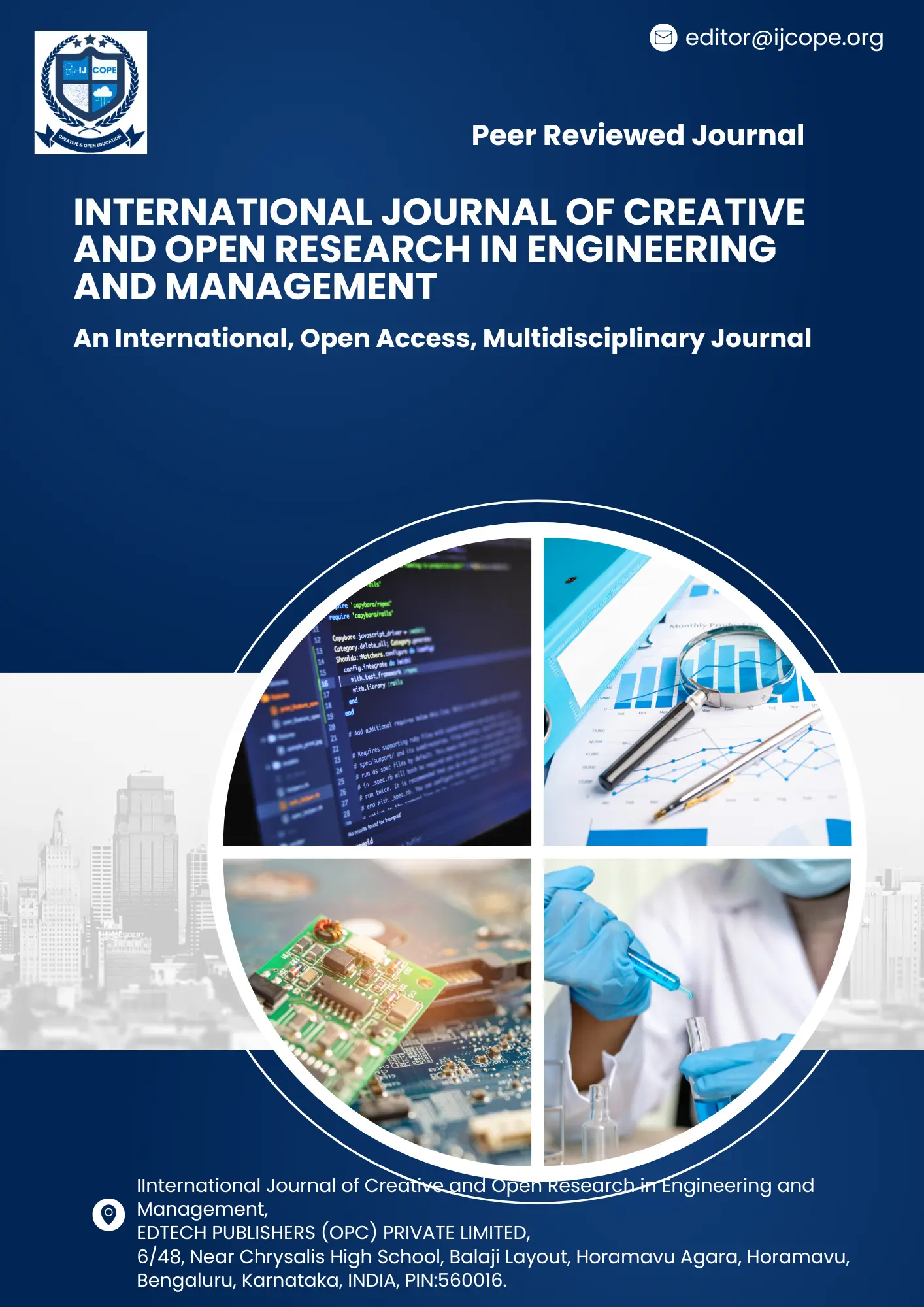Announcements
-
Peer Review Policy
Ijcope follows Strict Peer Review Policy -
Guidelines
IARJET follows double-blind peer review process to ensure high quality of Guidelines -
ISSN IS: 2583-0813
An International Open Access, Peer Reviewed Journal -
Call for Papers
July 2025. Ijcop invites all research papers for publication in Volume 4, Issue 4 -
Peer Review Policy
Ijcope follows Strict Peer Review Policy -
Guidelines
IARJET follows double-blind peer review process to ensure high quality of Guidelines -
ISSN IS: 2583-0813
An International Open Access, Peer Reviewed Journal -
Call for Papers
July 2025. Ijcop invites all research papers for publication in Volume 4, Issue 4

Submit Your Article Now
Design and Analysis of Smart Grid Systems with Renewable Energy Integration
Ms. Ananya Rathi, Mr. Vivek Sharma, Dr. Ramesh Tiwari, Associate Professor
Department of Electrical Engineering
Visvesvaraya Technological University (VTU)
Jnana Sangama, Belagavi – 590018, Karnataka, India
Abstract
in electricity distribution, incorporating advanced communication and control technologies alongside renewable energy sources to improve efficiency, reliability, and sustainability. This article offers a comprehensive analysis of smart grid systems, emphasizing their design, the integration of renewable energy sources such as solar and wind, and the associated challenges and solutions. It examines key components, including smart meters, advanced metering infrastructure (AMI), and energy management systems, while addressing issues related to grid stability, cybersecurity, and economic considerations. The article also proposes strategies for optimizing renewable energy integration and discusses future trends. Tables and figures are included to illustrate system architectures, performance metrics, and contributions of renewable energy.Smart grid systems represent a revolutionary approach to electricity distribution, leveraging cutting-edge communication and control technologies in conjunction with renewable energy sources. These systems aim to enhance efficiency, reliability, and sustainability in power delivery. The integration of smart meters, advanced metering infrastructure (AMI), and sophisticated energy management systems enables real-time monitoring, two-way communication between utilities and consumers, and dynamic load balancing. This infrastructure allows for more precise demand forecasting, improved fault detection, and rapid response to power fluctuations, ultimately leading to a more resilient and adaptive power grid.
The incorporation of renewable energy sources, particularly solar and wind, presents both opportunities and challenges for smart grid systems. While these clean energy sources contribute to reducing carbon emissions and dependence on fossil fuels, their intermittent nature necessitates advanced forecasting techniques and energy storage solutions. Smart grids address these challenges through intelligent control algorithms, distributed energy resources, and grid-scale energy storage systems. Additionally, the article explores the economic implications of smart grid implementation, including potential cost savings for consumers and utilities, as well as the initial investment required for infrastructure upgrades. Cybersecurity concerns are also addressed, highlighting the importance of robust protection measures to safeguard critical infrastructure from potential threats.
keywords:
Smart grid, Renewable energy, Energy management systems, Advanced metering infrastructure
References
- Alaguraj, R., & Kathirvel, C. (2023). Integration of Edge Computing-Enabled IoT Monitoring and Sharded Blockchain in a Renewable Energy-Based Smart Grid System. Electric Power Components and Systems, ahead-of-print(ahead-of-print), 1–16. https://doi.org/10.1080/15325008.2023.2293944
- Shahid, A. (2018). Smart Grid Integration of Renewable Energy Systems. 944–948. https://doi.org/10.1109/icrera.2018.8566827
- Bitzer, B., & Gebretsadik, E. S. (2013). Cloud computing framework for smart grid applications. 1–5. https://doi.org/10.1109/upec.2013.6714855
- Shafiullah, G. M., Oo, A. M. T., Ali, A. B. M. S., & Wolfs, P. (2013). Smart Grid for a Sustainable Future. Smart Grid and Renewable Energy, 04(01), 23–34. https://doi.org/10.4236/sgre.2013.41004
- Bhatti, H. J., & Danilovic, M. (2018). Making the World More Sustainable: Enabling Localized Energy Generation and Distribution on Decentralized Smart Grid Systems. World Journal of Engineering and Technology, 06(02), 350–382. https://doi.org/10.4236/wjet.2018.62022
- Tan, J. D., Chang, C. C. W., Bhuiyan, M. A. S., Minhad, K. N., & Ali, K. (2022). Advancements of wind energy conversion systems for low-wind urban environments: A review. Energy Reports, 8, 3406–3414. https://doi.org/10.1016/j.egyr.2022.02.153
- Al Haj Hassan, H., Pelov, A., & Nuaymi, L. (2015). Integrating Cellular Networks, Smart Grid, and Renewable Energy: Analysis, Architecture, and Challenges. IEEE Access, 3, 2755–2770. https://doi.org/10.1109/access.2015.2507781
- Huang, A. Q. (2017). Power Semiconductor Devices for Smart Grid and Renewable Energy Systems. Proceedings of the IEEE, 105(11), 2019–2047. https://doi.org/10.1109/jproc.2017.2687701
| Submission Last Date |
31/10/2025 |
| Acceptance Status |
within 6 Days |
| Paper Publish | within 5 Days |
- International Journal of Creative and Open Education
- EDTECH PUBLISHERS (OPC) PRIVATE LIMITED
- 6/48, Near Chrysalis High School, Balaji Layout, Horamavu Agara, Horamavu
- Bengaluru, Karnataka, PIN: 560016,India


